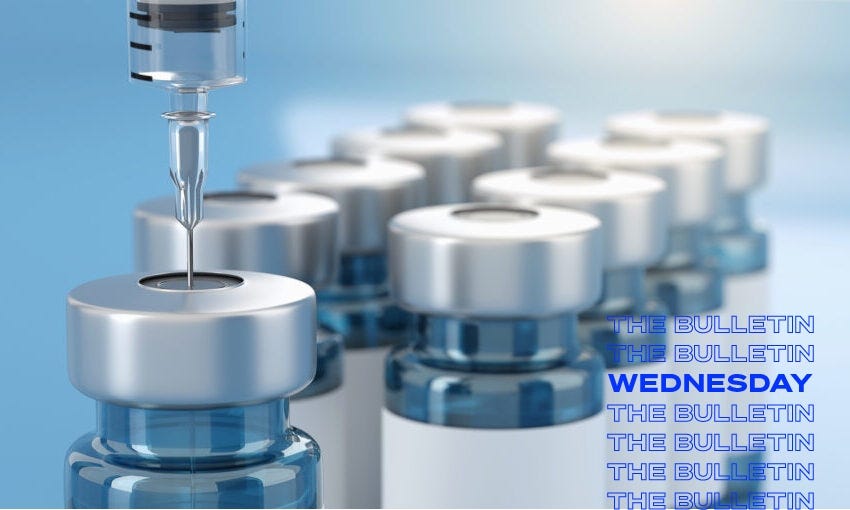The boosters are winning so far
New modelling provides insights into what the omicron outbreak could do over the next four months
Mōrena and welcome to The Bulletin for Wednesday, February 9, by Justin Giovannetti. Presented in partnership with Z Energy.
In today’s edition: $3 at the pump a ‘new normal’; anti-mandate protest pitches tents at parliament; National splits on conversion therapy ban; but first, our collective actions are slowing omicron.
About 60% of eligible New Zealanders are now boosted. (Getty Images)
The omicron outbreak will likely hit the country’s health system over the coming weeks. Omicron is spreading rapidly in New Zealand, with the daily number of new cases increasing at a rate unprecedented in the country’s Covid-19 pandemic. However, booster shots and restrictions are slowing that pace. Instead of worst case projections that warned of tens of thousands of daily infections by now, the seven-day rolling average of cases is just shy of 200. New modelling released yesterday by Te Pūnaha Matatini shouldn’t be seen as a sure bet on what might happen, but as scenarios of what we might face instead. The modelling helps us prepare for the future, Shaun Hendy told RNZ. The Spinoff's live updates looked at the modelling, which warns that hospital admissions could range from 200 to 800 daily. That will put enormous strain on the health system, emergency departments could still be overwhelmed.
It was two shots for delta and three for omicron: Ardern. Nearly 40,000 New Zealanders have gone in for a booster shot every day over the past week. As the new modelling shows, those boosted New Zealanders are now the main thing shielding the country from a public health crisis. The outbreak’s peak is now expected to hit in late March and the country’s immunisation campaign is what will help it through omicron. “The only reason we can even contemplate outbreaks totalling hundreds of thousands of cases now is that we have high vaccination rates, drastically reducing the risk of hospitalisation and death,” professor Michael Plank explained to One News.
We’re back to flattening the curve. Two years into Covid-19, the modellers looked at three scenarios for what New Zealand could face: South Australia (low outbreak), London (baseline) and New York (high). The prime minister said at parliament yesterday that she’s expecting the country will fit into the lower category, based on how health measures have worked so far. Those actions are flattening an otherwise steep omicron curve. As the NZ Herald reports, a low-level outbreak based on South Australia’s experience with 90% of New Zealanders boosted would be expected to yield 1.5 million infections, 11,500 hospitalisations and 460 deaths over four months.
Nearly 60% of eligible New Zealanders have now been boosted. Over one million people only became eligible last Friday when the government shaved a month off the waiting period, so that number could rise rapidly in the coming days. As Matthew Scott writes for Newsroom, in the seesaw between omicron and boosters, the boosters are winning so far.
Closing schools will be a ‘last resort’ to control omicron. At this early stage in the outbreak, the ministry of education confirmed to One News that 14 schools and 10 early learning centres are already managing cases. Right now, that means a pivot to online learning for some students and no widespread closures. After two years of disrupted class time, the NZ Herald reports that the prime minister has promised this time will be different. Schools will remain open as long as possible and will likely only close if so many teachers are infected that administrators can’t staff classrooms.
The Spinoff’s Covid data tracker has the latest figures.
Quality journalism shouldn’t be a privilege. This is why we are determined to keep our content freely available without a paywall. Help us continue to do so by joining The Spinoff Members today.
Is your organisation keen to support The Spinoff? We would love to hear from you – contact us today to find out more about our organisation memberships.
A $3 new normal at the pumps. Earlier this week a litre of 95 octane was selling for $2.99 near Wellington airport, while some stations in Auckland already blasted through the $3 barrier. As Stuff reports, some experts are warning that high prices are the new norm. The prime minister has blamed the international oil market, which now values a barrel of crude at around $91 US. That’s high, but nowhere near the records set in the late 2000s. The Spinoff has looked at the price at the pump, and while expensive imported oil is part of it, the government’s tax take is also increasing, as is the margin importers are keeping on the oil they do bring in. While New Zealand has no say on international markets, the government wants fuel companies to cut their profits, while the opposition wants the government to cut its taxes.
The anti-mandate convoy arrives at parliament and promises to stay for days. The Dominion Post reports on the so-called “freedom convoy” that snarled traffic around parliament and caused some local businesses to close as staff faced abuse. The owner of the Backbencher pub, across the road from parliament, said it was the angriest protest he’s seen in three decades. The convoy organisers have said they want an end to Covid-19 restrictions, while many of the signs held up by the crowd called for government and media to be arrested for treason. Protesters began clashing with commuters in the evening, including children in school uniforms. The protesters have said they’ll stay camped out at parliament until their demands are met.
The prime minister responded by saying the protesters aren’t the majority. The 30,000 who had a jab yesterday were part of the majority, she said. “The majority of New Zealanders have done everything they can to keep each other safe,” Ardern told reporters. A Newshub poll found that the majority of New Zealanders want the border to remain closed and a plurality support going back into lockdown to control omicron.
A conscience vote on conversion therapy splits the National party. Returning to parliament for the first time in 2022, four of the party’s top MPs were asked how they’d vote on banning the practice. The Spinoff’s live updates reported that leader Christopher Luxon, deputy Nicola Willis and Chris Bishop voted on the second reading to ban conversion therapy. With a wide smile, Bishop said voting to end conversion therapy is the right thing to do. Only moments earlier, Simon Bridges had stood exactly where Bishop had been and said he’d vote against the ban. He said it was a controversial bill and lacked nuance. “Parents should be allowed to be parents,” he said.
In the end, Bridges wasn’t joined by many on the National side. Despite the caucus being whipped to vote against the first reading last year, only seven exercised a conscience vote during yesterday evening’s second reading. They were Simon Bridges, Simeon Brown, Melissa Lee, Simon O'Connor, Shane Reti, Louise Upston and Michael Woodhouse.
A business decision made in London could have a huge impact on New Zealand’s climate ambitions. Tiwai Point owners Rio Tinto have signalled they want to keep the smelter open past its 2024 closure date because of high aluminium prices. As RNZ reports, the closure of that one industrial facility was seen as a key to battling climate change. It isn’t that Tiwai Point pollutes an inordinate amount, it’s all the electricity it gobbles up. Staying open means plans to build a hydrogen plant and data centre in Southland are likely on hold. It also raises the question of where future electric vehicles will get the power they need.
Sydney to get a marae as Māori in Australia receive approval to build. It took nearly 30 years to raise the necessary funds, but Te Ao Māori news reports on a landmark deal to build a marae in southwest Sydney, the first of its kind outside New Zealand. A third of the 150,000 Māori who live in Australia are in New South Wales and it’ll be a place for them to connect with each other and whānau back home. The aboriginal Darug people will also be involved, creating connections between indigenous peoples.
Got some feedback about The Bulletin, or anything in the news?
Get in touch with me at thebulletin@thespinoff.co.nz
Right now on The Spinoff: Toby Manhire looks at the state of politics the year before the next election. Chris Schulz pledges to finish a TV show in 2022. Tara Ward reviews the bright new set of AM. Sam Brooks speaks with HS Valley, who wrote about a school of magic under Fox Glacier. Josie Adams finds out why the last 1% of a phone’s battery lasts forever.
For a longer read, the long road to electric cars. The graphics team at Reuters has been turning out some really strong pieces over the past few months. The newswire’s latest offering looks at electric cars in the US and the logistical struggle it’ll be to have a carbon neutral road network by 2050. While the pendulum is swinging towards more electrics, about half of adults aren’t interested in making the switch. What’s clear from the piece is that the move to electrics won’t be one big rush away from petrol, but will build and ebb over time.
Auditing how much it would cost to defend the America’s Cup. A businessman who wants to keep the cup defence in Auckland has offered to pay a high-level accounting firm to audit Team New Zealand’s budget, the NZ Herald (paywalled) reports. At the centre of the dispute is the price tag to mount a local cup defence. Team NZ says a budget put forward by local boosters has a $50 million deficit that would destroy the organisation. The locals contend that Team NZ’s proposed budget for taking the defence overseas instead has a $50 million profit.






